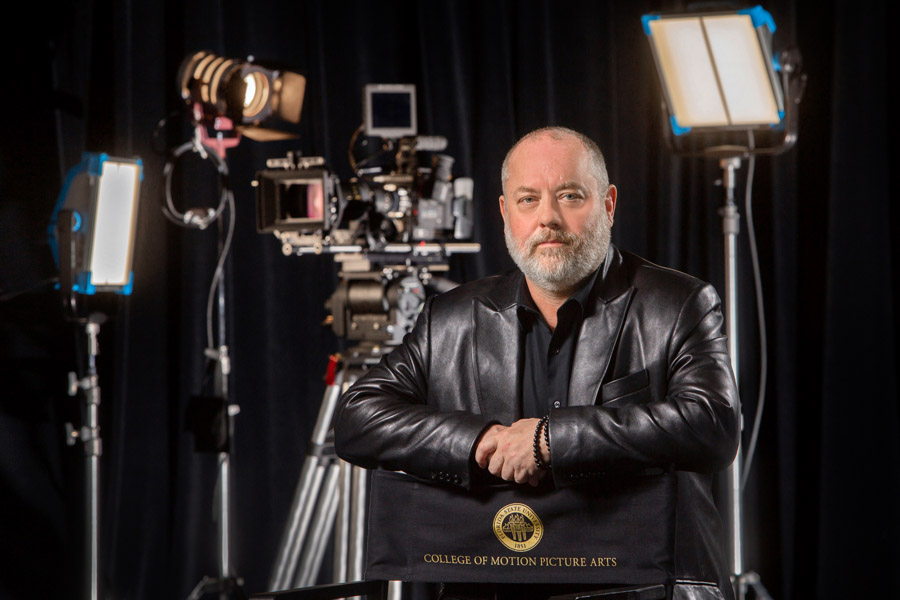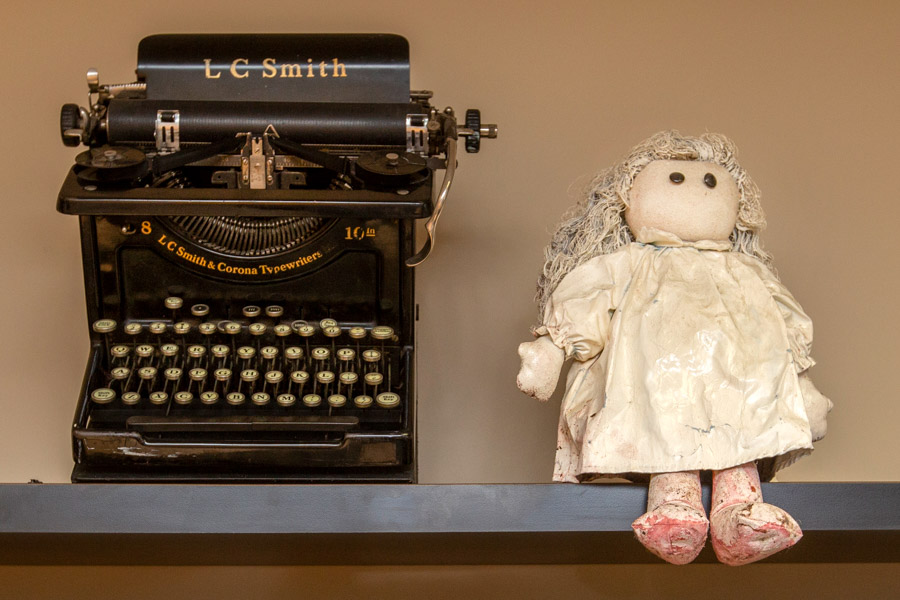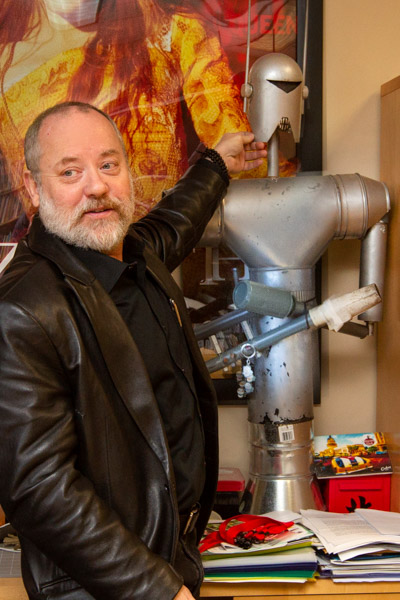
The narrative of Reb Braddock’s life as a filmmaker, teacher and creator reads a little like a Hollywood script you couldn’t write because no one would believe it.
“A story about a guy who starts out working in the film equipment room signing out cameras and ends up in the dean’s office in charge of the whole school stretches the imagination,” Braddock said with a laugh. “It’s an honor to serve in this job.”
Braddock, an FSU film school graduate himself, has another great story to tell this year.
A half dozen Florida State graduates worked on Oscar-nominated films; alumnus Barry Jenkins, who won an Oscar in 2017, received another nomination; and several students earned elite honors. Junior Shae Demandt won a Student Academy Award and seniors Nicholas Markart and Tyler Knutt screened their film at the Cannes Film Festival.
It’s a streak of success spotlighting the palpable momentum at the film school.
“Over the past five years, we saw the school was turning the corner because a lot of FSU graduates had worked their way into substantial roles in the film business: executive producers, writers, filmmakers like Barry Jenkins and David Mitchell making independent films,” Braddock said.
“I’m not sure we thought we’d have a graduate win an Academy Award so fast with Barry. But we knew Florida State’s reputation was rising in the film industry, and it was another sign we’d built a special film school.”
Birth of a film school
FSU’s College of Motion Picture Arts was created by the Florida Legislature in 1989 and initially set up in Sarasota. Braddock enrolled as a graduate student there to pursue a Master of Fine Arts because he envisioned a new chapter for his developing film career.
He had already worked as a cinematographer in Hollywood for several years, but a nagging question was ever-present. He wondered if he’d get the chance to realize his main career ambition to work as a director.
So, Braddock left Hollywood and headed to FSU’s new Sarasota-based film school.
“I fell in love with this program the day I walked in because it was new and exciting,” Braddock recalled. “The film school was trying to find its way by hiring some faculty members who were great indie filmmakers from Miami. They were passionate people who made films.”
“Magic”
Braddock said the film school found its rhythm because of that contingent of creative filmmakers. From the start, they aspired to build the ultimate film school — a conservatory that eschewed the conventional teaching practices of the era and instead incorporated new, more practical ways of training student-filmmakers.
That forward-thinking approach allowed Braddock, even as a graduate student, to help shape the curriculum. He worked on that vision with his mentor Frank Patterson, then a faculty member at the film school and later dean of the college from 2003 to 2016.
Together, they “back-timed the curriculum,” meaning they laid out each academic step that a student would have to take to get a finished film to a screening.
Part of that design meant the school, which moved to Tallahassee in 1995, would pay students’ production costs, allow them to use equipment for free and train them in a limited-access program with only 24 students a year. Those were the building blocks, Braddock said, and that kind of film school did not exist anywhere else at the time.
“The film school was designed as a conservatory, masterfully set up with a mission to train men and women for careers in the motion picture industry and, most importantly, give them what they needed to succeed,” Braddock said.
“It was magic.”
Those have been key values at the film school from the start, and Braddock has fought hard to protect them over the past 30 years.
Renewing core values was one of Braddock’s main goals when he became dean of the College of Motion Picture Arts in June 2017. Provost and Executive Vice President for Academic Affairs Sally McRorie described Braddock as the right person to lead the film school into the future because of his successful record working with students and faculty, “disrupting the status quo” and expanding creative boundaries.

The Super 8 discovery
Braddock has been expanding creative boundaries ever since he discovered his dad’s Super 8 film camera in the den of his home at the age of 10. Fascinated, he examined the reels of film recorded by his father, a military pilot who flew C-130 Hercules transport planes to Antarctica. That explained why the film reels contained lots of shots of penguins waddling across the frozen tundra.
It was a breakthrough moment for Braddock, one that would guide the trajectory of his life. The discovery opened up a new world of imagination and possibilities.
He immediately dashed to the neighborhood drug store and used his allowance to buy Super 8 film.
“From then on,” Braddock said, “I was hooked.”
His filmmaking fervor resonated with friends, and soon he’d enlisted them in a neighborhood movie company for kids. They wrote scripts, acted out scenes, and through trial and error they made movies fueled by pure inspiration.
Braddock made his first film when he was 11, a sci-fi called “The Secret of the Sacred Flying Fish.” Creativity flourished.
That creative spirit and passion for filmmaking led him to the University of Oklahoma, mainly because “old-school Hollywood producer” Ned Hochman taught there. Braddock said he wanted to learn how to become a good storyteller from a mentor with bona fides in the film industry.
“I really wanted to make stories for the big screen,” he said.
Make it happen

That dream fed his enthusiasm and sheer inventiveness. He threw himself into his first undergraduate film, “They Are Machines,” a sci-fi adventure about the last humans on Earth after robots had taken over.
Braddock wanted to create a robot predator for the movie, but as a cash-strapped college student the special effects budget was limited, so he had to be resourceful.
Braddock built the robot himself by refashioning mundane household items, such as 2-liter Coke bottles and caps, a tube from his mom’s vacuum cleaner, ductwork and “random stuff from the hardware store.” In addition to building props, he wrote the script, recorded the scenes while simultaneously puppeting the handmade robot, animated fiery laser blasts from the robot and directed the film.
Braddock made it happen. It was an invaluable lesson.
That’s why for another student-film project, he returned to the hardware store and bought four-by-fours to build an enormous camera crane that would allow him to get a crucial, but crazy-difficult, rotating overhead shot of actors sitting at a table. Braddock had made up his mind, and he got the shot.
The experience confirmed his earlier lesson: Believe in an idea and go make it happen, whether it’s getting a single camera shot, making an entire feature film or building the ultimate film school.
“This is a philosophy — you have to become a renaissance filmmaker to be a great filmmaker,” Braddock said. “You need to know how the whole machine works. As an example, that’s how Barry Jenkins was able to make his first film (‘Medicine for Melancholy’) with only five people. Each person knew how to do multiple jobs to cover the most important elements.”
Jenkins clearly remembers that lesson at FSU. He learned that becoming a “renaissance filmmaker” and understanding all the components of filmmaking would help him tell a better story.
“Reb was very diligent about preserving the idea that filmmaking was a blue-collar art form, meaning a student could not just be an artist — you’d have to know how to operate all the machinery,” Jenkins said. “I think my films look the way they do because FSU instilled in me that you have to know how all this different gear operates to create your own voice or style.”
Renaissance filmmaker
Braddock is the quintessential renaissance filmmaker — an artist and movie “gear guy” who knows his way around a hardware store and a film equipment room — because he’s figured out that integrating all elements of filmmaking can reveal the best path to telling a good story.
Most importantly, Braddock has helped build Florida State’s film school and boost students, so they can take their big dreams of being nominated for an Oscar and make them happen.
“I love Florida State University and the way it’s centered, and I think we’re in a golden time for the university,” Braddock said. “There is so much great stuff happening. It feels like the film school is taking its next leap along with FSU, so we are both in synchrony.”




